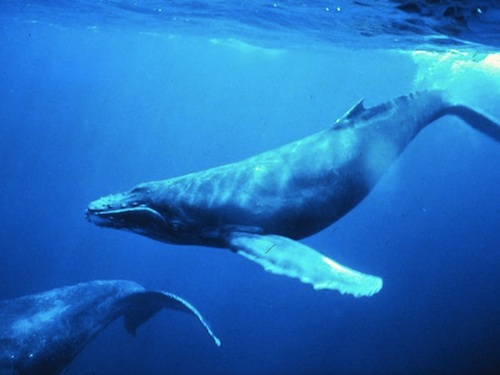Last night, 60 Minutes did a piece on humpback whales. Two quick side notes before I get going here: (a) with the amount (and the distances) that Scott Pelley travels for his long-form features, how does he ever host the nightly news? and (b) how cool is it that an old-media darling like 60 Minutes still puts full versions of their features on YouTube?
One of the most interesting aspects was about “the song” of the humpback whale. Essentially, males go fully vertical and sing a song — it’s not really a song as humans understand it, of course, but it’s a series of sounds that can take many different auditory compositions — and then, the next year, the song will be different. Animal communication is endlessly fascinating to me. Some of the foremost experts on humpback whale songs will admit they have “no idea” what the whales are trying to convey. It is thought that the songs are regionally-specific, though (this has been challenged in the Indian Ocean); the songs can be heard for 20 miles, and while initially thought to be mating rituals, now they are considered to potentially be the issuance of a threat. Humpback whales don’t have vocal cords, so the “songs” — which are similar in composition to human music — are ostensibly sounds being generated in their heads.
Some of this makes sense, since it appears that whales might actually develop a culture of their own via a form of the social network. A non-local whale was more likely to use the “lobtailing” approach to catching fish when paired with a local male (in the Gulf of Maine); this underscores the idea that whales pass along customs and ideas to one another. The problem is, this is all rooted in observational study — the whales could just see things from other whales in the vicinity and mimic it; that doesn’t necessarily imply culture. But since it’s fairly complicated to bring whales into a lab and do controlled experiments, this could be the farthest extent of what we’ll know about how they interact.
On the interaction front: according to a lengthy New York Times Magazine piece from 2009, it’s theoretically possible that whales and researchers were once attempting a form of interspecies communication. Another absolutely insane thing I learned: humpback whales may be astronomers too! And before I stop this humpback whale tangent and go back to the communication angle, did you know there’s apparently one albino humpback whale in the world? He’s got a name too. Migaloo.
Here’s one video about the complex communication systems that my new best friends employ. And here’s 1 hour of humpback whale songs, meant to be used for relaxation or sleep. Like the marine biologist who moved from the U.S. to the South Pacific and found herself there 16 years later, I have absolutely no clue what the whales are trying to say to each other Since only males sing the songs, it likely has something to do with mating or masculine assurances (health, vitality, aggression, etc.) But it’s endlessly fascinating to me (probably far more fascinating than the 90-degree side rolls that whales will do): how do animals figure out what their species is saying to them? Is it just inherent, like the development of human language? (Provided “inherent” is the right word there.) Or is it a far more complicated system under the ocean waters?

Reblogged this on Freedom for Cetaceans.
Reblogged this on Sherlockian's Blog.